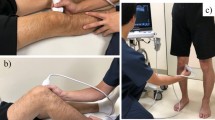Abstract
Purpose
To prospectively evaluate whether age of patient affects diagnostic accuracy of sonography and magnetic resonance imaging (MRI) in the diagnosis of medial meniscal tears.
Methods
We prospectively evaluated 74 consecutive patients (54 males and 20 females), in two different groups [group A (37 patients ≤ 30 years; mean age: 23.5 ± 5 years) and group B (37 patients > 30 years; mean age: 43.5 ± 9.35 years)] with clinical suspicion of medial meniscal tear. After inclusion, patients underwent ultrasonography and then MRI for signs of tearing. The ultrasonographic and MRI findings were compared with arthroscopic findings, which served as a gold standard for accurate detection of meniscal tearing.
Results
The sensitivity, specificity, positive and negative predictive values and accuracy of ultrasonography in detecting medial meniscal tears in group A were 100, 88.9, 96.5, 100, 97.3 % and in group B were 83.3, 71.4, 92.6, 50, 81.1 %, respectively. The sensitivity, specificity, positive and negative predictive values and accuracy of MRI in group A were 100, 88.9, 96.5, 100, 97.3 % and in group B were 96.7, 85.7, 96.7, 85.7, 94.6 %, respectively.
Conclusions
Given the fact that the sensitivity and specificity of the results of knee sonography matched that of MRI in patients who were 30 years old or less, we suggest ultrasonography as an effective initial investigation for tears of medial meniscus in this group of patients. Patients with negative ultrasonographic findings will need no further investigation.
Level of evidence
Diagnostic studies—investigating a diagnostic test, Level II.



Similar content being viewed by others
References
Grifka J, Richter J, Gumatau M (1994) Clinical and sonographic meniscus diagnosis. Orthopade 23:102–111
Najafi J, AbdolahzedehLahiji F, Bagheri Sh (2005) The diagnostic value of sonography in bucket handle tear of meniscus and complete MCL tear compared with arthroscopy. Iran J Radiol 3(1):103–106
Ireland J, Trickey EL, Stoker DJ (1980) Arthroscopy and arthrography of the knee: a critical review. J Bone Joint Surg Br 62-B:3–6
Oei EHG, Ginai AZ, Hunink MGM (2007) MRI for traumatic knee injury: a review. Semin Ultrasound CT MR 28:141–157
Crues JV 3rd, Mink J, Levy TL, Lotysch M, Stoller DW (1987) Meniscal tears of the knee: accuracy of MR imaging. Radiology 164:445–448
Mackenzie R, Palmer CR, Lomas DJ, Dixon AK (1996) Magnetic resonance imaging of the knee: diagnostic performance studies. Clin Radiol 51:251–257
Park GY, Kim JM, Lee SM, Lee MY (2008) The value of ultrasonography in the detection of meniscal tears diagnosed by magnetic resonance imaging. Am J Phys Med Rehabil 87:14–20
Bauer G, Burri C, Swobodnik W (1987) Meniskussonographie. Deutsch Zeitung Sportmedezin 38:74
Jerosch J, Castro WH, Sons HU, Winkelmann W (1989) The value of sonography in injuries of the knee joint. Ultraschall Med 10:275–281
Boos N, Bugyi I (1989) The value of meniscus sonography of the knee joint. Unfallchirurg 92:435–439
Casser HR, Füsting M (1993) Current developments in ultrasonography of the meniscus. Orthopadie 22:307–316
Azzoni R, Cabitza P (2002) Is there a role for sonography in the diagnosis of tears of the knee menisci? J Clin Ultrasound 30:472–476
Rutten MJ, Collins JM, van Kampen A, Jager GJ (1998) Meniscal cysts: detection with high-resolution sonography. Am J Roentgenol 171:491–496
Gerngross H, Sohn C (1992) Ultrasound scanning for the diagnosis of meniscal lesions of the knee joint. Arthroscopy 8:105–110
Shetty AA, Tindall AJ, James KD, Relwani J, Fernando KW (2008) Accuracy of hand-held ultrasound scanning in detecting meniscal tears. J Bone Joint Surg Br 90-B:1045–1048
World Medical Association. Declaration of Helsinki-Ethical principles for medical research involving human subjects. Last Accessed 5 Jun 2012. Available from: http://www.wma.net/en/30publications/10policies/b3/index.html
Heuchemer T, Bauer G, Friedrich JM, Bargon G (1987-1989). Clinical use of meniscus sonography. Bildgebung 56:118–123
Bruce W, Lee TS, Sundarajan V, Walker P, Magnussen J, Van der Wall H (2004) Performance characteristics of ultrasound of the knee in a general radiological setting. Knee 11:303–306
Wareluk P, Szopinski KT (2012) Value of modern sonography in assessment of meniscal lesions. Eur J Radiol 81:2366–2369
Conflict of interest
The authors declare that they have no relevant financial interests and no potential benefits in any form from a commercial party related directly or indirectly to the subject of this manuscript or any of them in this manuscript.
Author information
Authors and Affiliations
Corresponding author
Rights and permissions
About this article
Cite this article
Alizadeh, A., Babaei Jandaghi, A., Keshavarz Zirak, A. et al. Knee sonography as a diagnostic test for medial meniscal tears in young patients. Eur J Orthop Surg Traumatol 23, 927–931 (2013). https://doi.org/10.1007/s00590-012-1111-z
Received:
Accepted:
Published:
Issue Date:
DOI: https://doi.org/10.1007/s00590-012-1111-z




